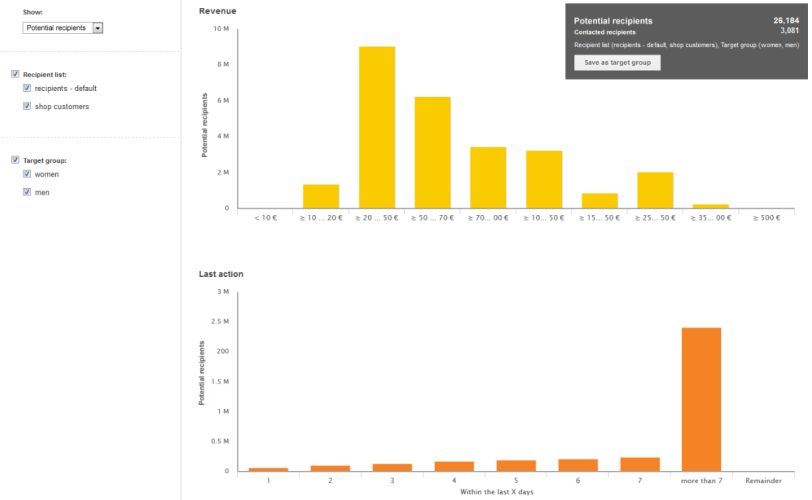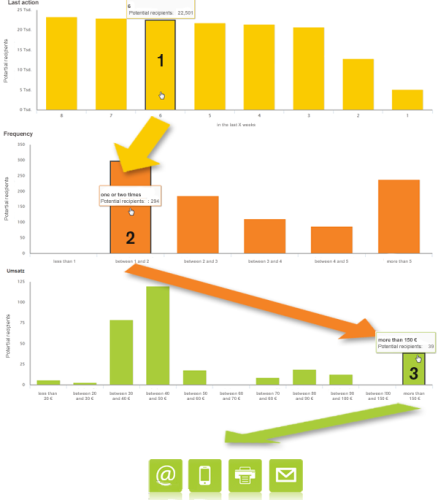 Live Analytics detail view
Live Analytics detail view
The detail view shows limitations selected in the analysis accompanied by recipient segments as a chart. The upper right corner of the window shows the total number of recipients of segments and the analysis parameters. Use the Save as Target Group button to save the selected segments as a target group.
Displaying recipients
In the left column, at the top in each detail view of an analysis, use the Show drop-down list to choose between display options:
- Potential recipients. Potential recipients of the selected segments; that is, recipients from the recipient lists that correspond to the defined criteria. If you change the limitations of an analysis or select individual segments, the number of potential recipients is adjusted in real time. This number can include recipients who currently receive no mailings because they unsubscribed from the newsletter, exceeded the bounce Hard bounces occur when an email cannot be delivered due to a permanent error (for example because the email address no longer exists). limit, or are blocked Recipients whose email addresses are on the blocklist will never again receive email from you. This applies even if recipients subscribe to newsletters again later. To reverse this status, remove the recipient from the blocklist..
- Contacted recipients. Recipients in the current selection who received at least one mailing. This does not mean that a campaign was sent with the segment shown in the analysis; it means that recipients were addressed using the same recipient lists and target groups as in the current analysis.
Activating limitations
The selected limitations are displayed in the left column. Refine or expand the displayed analysis by activating or deactivating limitations:
- Entire limitation. Clear to exclude the entire limitation.
- Individual segments of a limitation. Clear to exclude a segment from an analysis.
- Interval or threshold value for numeric values. To adjust the limitation interval or threshold value, move the slider for an interval or threshold value limitation.
- Time interval for date fields. To set or adjust the time interval, click the left date field and enter a starting date using the calendar. Then, click the right date field and enter an end date.
Limitations
- If you select some limitations (not all), the number of potential recipients in an analysis decreases or remains the same.
- If you select a limitation but the number of potential recipients does not change, the limitation is not relevant for the analysis.
- If you select all limitations, the number of potential recipients increase, because all recipients from your client are considered.
Displaying ad-hoc segmentation
To receive the selected recipient segment, click a bar, point, or slice of the pie in a chart. The display of analysis data in the upper right changes to display the potential recipients and contacted recipients in the selected segment. If you created multiple charts in an analysis, the display changes in these charts too. Only recipients from the segment selected in the first chart are still displayed there.
You can now refine the selection of recipients by selecting an additional segment in these charts. After each selection, the display of the other charts adjusts to the refined selection.
The order in which you make the selection does not matter. You can start with any chart then select a segment in the other charts.
Example: Recipient segment from an RFM analysis:
- Recipients whose most recent action (purchase, product view, abandoned shopping cart) took place in the last 6 weeks are selected.
- These recipients are further limited to ones who performed one or two actions in the last 12 months. Purchases, product views and abandoned shopping carts are evaluated here too.
- These recipients are limited to those whose purchases exceeded €150 in the last 12 months.
Saving a segment as a target group
After you select the desired recipient segment, you can save it as a target group Subset of recipients defined by rules and conditions and a logic relationship between them. For example, all recipients in the United Kingdom. to address these recipients in a campaign.

If a recipient is included in multiple categories, the potential recipients displayed in Live Analytics may differ from the actual number of recipients. If you want to calculate the exact number of potential recipients, use the analysis feature in the Create Target Group window (see also Target group analysis).
To save a segment as a target group, perform the following steps:
- Hover over the gray field in the upper right corner in which the analysis data is displayed. The field becomes active and highlighted.
- Click Save as Target Group. The Create Target Group window opens.
- In the Target Group Definition area, in the Client list, select the client for which you want to create the target group.
- Click Properties.
- Optionally, select a folder in which you want to save this target group.
- The name of the target group is generated according to the scheme Created from [analysis title] on [date] at [time]. If you want to give it a distinct name, delete this and enter the desired name.
- Optionally, enter a description of the target group.
- Click Create.
You can now select the target group in a regular campaign (in the menu item Smart Campaigns), or in an automated campaign (in the menu item Marketing Automation) and create a campaign for these recipients.

